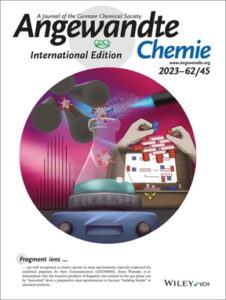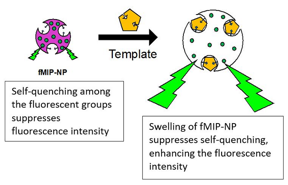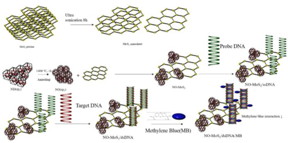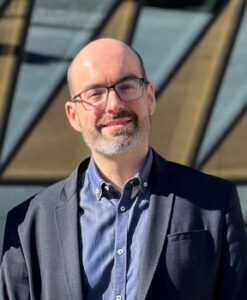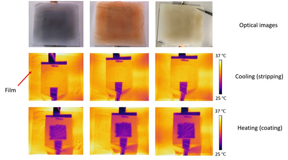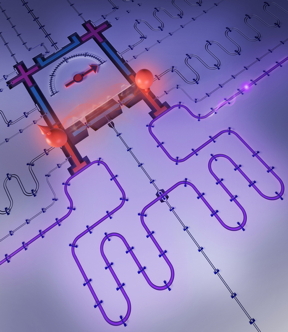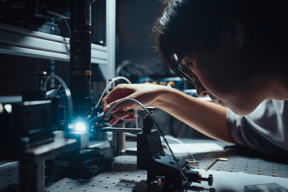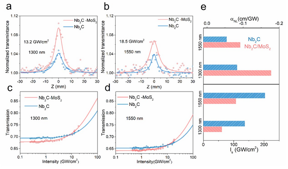Home > Press > Novel microscope developed to design better high-performance batteries: Innovation gives researchers inside view of how batteries work
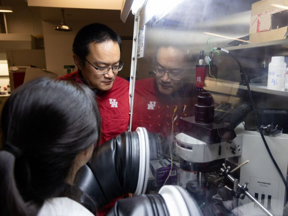 |
| As Professor Xiaonan Shan observes, University of Houston graduate Guangxia Feng works on the operando reflection interference microscope (RIM) inside a “glove box” because the lithium-ion battery electrolyte is flammable. CREDIT University of Houston |
Abstract:
Lithium-ion batteries have transformed everyday lives – almost everyone has a smartphone, more electric vehicles can be spotted on the roads, and they keep power generators going during emergencies. As more portable electronic devices, electric vehicles and large-scale grid implementations come online, the demand for higher energy density batteries that are safe and affordable continues to grow.
Novel microscope developed to design better high-performance batteries: Innovation gives researchers inside view of how batteries work
Houston, TX | Posted on February 10th, 2023
Now, a University of Houston research team, in collaboration with researchers from the Pacific Northwest National Laboratory and the U.S. Army Research Laboratory, has developed an operando reflection interference microscope (RIM) that provides a better understanding of how batteries work, which has significant implications for the next generation of batteries.
“We have achieved real-time visualization of solid electrolyte interphase (SEI) dynamics for the first time,” said Xiaonan Shan, assistant professor of electrical and computer engineering at UH’s Cullen College of Engineering and corresponding author of a study published in the journal Nature Nanotechnology. “This provides key insight into the rational design of interphases, a battery component that has been the least understood and most challenging barrier to developing electrolytes for future batteries.”
The highly sensitive microscope allows researchers to study the SEI layer, which is an extremely thin and fragile layer on the battery electrode surface that determines battery performance. Its chemical composition and morphology are continuously changing – making it a challenge to study.
“A dynamic, non-invasive and high sensitivity operando imaging tool is required to understand the formation and evolution of SEI. Such a technique capable of direct probing SEI has been rare and highly desirable,” said Yan Yao, the Hugh Roy and Lillie Cranz Cullen Distinguished Professor of electrical and computer engineering and a co-corresponding author who has worked with Shan on this project for the last four years.
“We have now demonstrated that RIM is the first of its kind to provide critical insight into the working mechanism of the SEI layer and help design better high-performance batteries,” said Yao, who is also the principal investigator of the Texas Center for Superconductivity at the University of Houston.
How it works
The research team applied the principle of interference reflection microscopy in the project, where the light beam – centering at 600 nanometers with spectrum width of about 10 nanometers – was directed towards the electrodes and SEI layers and reflected. The collected optical intensity contains interference signals between different layers, carrying important information about the evolution process of SEI and allowing the researchers to observe the entire reaction process.
“The RIM is very sensitive to surface variations, which enables us to monitor the same location with large-scale high spatial and temporal resolution,” said UH graduate student Guangxia Feng, who performed much of the experimental work on the project.
The researchers note that most battery researchers currently use cryo-electron microscopes, which only take one picture at a certain time and cannot continuously track the changes at the same location.
“I wanted to approach energy research from a different angle by adapting and developing new characterization and imaging methods which provide new information to understand the reaction mechanism in energy conversion processes,” said Shan, who specializes in developing imaging techniques and spectrometry techniques to study electrochemical reactions in energy storage and conversions. This new imaging technique could also be applied to other state-of-the-art energy storage systems.
Feng, who earned a Ph.D. in electrical engineering from UH in 2022, plans to pursue further research in the growing field of battery technology.
“To realize the next generation of batteries, it is essential to understand the reaction mechanisms and novel materials,” she said, adding that developing higher energy batteries also benefits the environment. “I have always wanted to be a scientist because they can make great things happen for people and change the world for the better.”
Wu Xu from Pacific Northwest National Lab, an expert in the electrolyte designs, helped with the project design and provided critical insight on the electrolyte to use. Kang Xu, an expert in the SEI research at the Army Research Lab, provided significant insights to help understand the phenomenon observed. Both are co-corresponding authors for the paper.
Feng and another UH engineering student Yaping Shi, along with Hao Jia from PNNL, are the lead authors of the study. Other contributors are Xu Yan, Yanliang Liang, Chaojie Yang and Ye Zhang from UH; Mark Engelhard at PNNL.
####
For more information, please click here
Contacts:
Rashda Khan
University of Houston
Copyright © University of Houston
If you have a comment, please Contact us.
Issuers of news releases, not 7th Wave, Inc. or Nanotechnology Now, are solely responsible for the accuracy of the content.
| Related Links |
| Related News Press |
News and information
![]() Graphene Flagship start-up Bedimensional closes a second €10 million investment round February 10th, 2023
Graphene Flagship start-up Bedimensional closes a second €10 million investment round February 10th, 2023
![]() Make them thin enough, and antiferroelectric materials become ferroelectric February 10th, 2023
Make them thin enough, and antiferroelectric materials become ferroelectric February 10th, 2023
Laboratories
![]() UC Irvine researchers decipher atomic-scale imperfections in lithium-ion batteries: Team used super high-resolution microscopy enhanced by deep machine learning January 27th, 2023
UC Irvine researchers decipher atomic-scale imperfections in lithium-ion batteries: Team used super high-resolution microscopy enhanced by deep machine learning January 27th, 2023
![]() New method addresses problem with perovskite solar cells: NREL researchers provide growth approach that boosts efficiency, stability December 29th, 2022
New method addresses problem with perovskite solar cells: NREL researchers provide growth approach that boosts efficiency, stability December 29th, 2022
Imaging
![]() Wafer-scale 2D MoTe₂ layers enable highly-sensitive broadband integrated infrared detector January 6th, 2023
Wafer-scale 2D MoTe₂ layers enable highly-sensitive broadband integrated infrared detector January 6th, 2023
![]() Shrinking hydrogels enlarge nanofabrication options: Researchers from Pittsburgh and Hong Kong print intricate, 2D and 3D patterns December 29th, 2022
Shrinking hydrogels enlarge nanofabrication options: Researchers from Pittsburgh and Hong Kong print intricate, 2D and 3D patterns December 29th, 2022
![]() New X-ray imaging technique to study the transient phases of quantum materials December 29th, 2022
New X-ray imaging technique to study the transient phases of quantum materials December 29th, 2022
Govt.-Legislation/Regulation/Funding/Policy
![]() Graphene Flagship start-up Bedimensional closes a second €10 million investment round February 10th, 2023
Graphene Flagship start-up Bedimensional closes a second €10 million investment round February 10th, 2023
![]() Make them thin enough, and antiferroelectric materials become ferroelectric February 10th, 2023
Make them thin enough, and antiferroelectric materials become ferroelectric February 10th, 2023
Possible Futures
![]() Make them thin enough, and antiferroelectric materials become ferroelectric February 10th, 2023
Make them thin enough, and antiferroelectric materials become ferroelectric February 10th, 2023
Discoveries
![]() Make them thin enough, and antiferroelectric materials become ferroelectric February 10th, 2023
Make them thin enough, and antiferroelectric materials become ferroelectric February 10th, 2023
Announcements
![]() Graphene Flagship start-up Bedimensional closes a second €10 million investment round February 10th, 2023
Graphene Flagship start-up Bedimensional closes a second €10 million investment round February 10th, 2023
![]() Fiber sensing scientists invent 3D printed fiber microprobe for measuring in vivo biomechanical properties of tissue and even single cell February 10th, 2023
Fiber sensing scientists invent 3D printed fiber microprobe for measuring in vivo biomechanical properties of tissue and even single cell February 10th, 2023
![]() Photonic Materials: Recent Advances and Emerging Applications February 10th, 2023
Photonic Materials: Recent Advances and Emerging Applications February 10th, 2023
![]() Make them thin enough, and antiferroelectric materials become ferroelectric February 10th, 2023
Make them thin enough, and antiferroelectric materials become ferroelectric February 10th, 2023
Tools
![]() Shrinking hydrogels enlarge nanofabrication options: Researchers from Pittsburgh and Hong Kong print intricate, 2D and 3D patterns December 29th, 2022
Shrinking hydrogels enlarge nanofabrication options: Researchers from Pittsburgh and Hong Kong print intricate, 2D and 3D patterns December 29th, 2022
![]() Rapid fluorescent mapping of electrochemically induced local pH changes December 9th, 2022
Rapid fluorescent mapping of electrochemically induced local pH changes December 9th, 2022
Automotive/Transportation
![]() UC Irvine researchers decipher atomic-scale imperfections in lithium-ion batteries: Team used super high-resolution microscopy enhanced by deep machine learning January 27th, 2023
UC Irvine researchers decipher atomic-scale imperfections in lithium-ion batteries: Team used super high-resolution microscopy enhanced by deep machine learning January 27th, 2023
![]() New nanowire sensors are the next step in the Internet of Things January 6th, 2023
New nanowire sensors are the next step in the Internet of Things January 6th, 2023
Battery Technology/Capacitors/Generators/Piezoelectrics/Thermoelectrics/Energy storage
![]() Make them thin enough, and antiferroelectric materials become ferroelectric February 10th, 2023
Make them thin enough, and antiferroelectric materials become ferroelectric February 10th, 2023
![]() UC Irvine researchers decipher atomic-scale imperfections in lithium-ion batteries: Team used super high-resolution microscopy enhanced by deep machine learning January 27th, 2023
UC Irvine researchers decipher atomic-scale imperfections in lithium-ion batteries: Team used super high-resolution microscopy enhanced by deep machine learning January 27th, 2023
![]() Correlated rattling atomic chains reduce thermal conductivity of materials January 20th, 2023
Correlated rattling atomic chains reduce thermal conductivity of materials January 20th, 2023
- SEO Powered Content & PR Distribution. Get Amplified Today.
- Platoblockchain. Web3 Metaverse Intelligence. Knowledge Amplified. Access Here.
- Source: http://www.nanotech-now.com/news.cgi?story_id=57300
- 10
- 2022
- 27th
- 2D
- 3d
- a
- About
- accuracy
- accurate
- Achieve
- achieved
- addresses
- advance
- advanced
- advances
- affordable
- Allowing
- allows
- always
- and
- Another
- applied
- approach
- Army
- Assistant
- author
- authors
- Bandwidth
- barrier
- batteries
- battery
- Beam
- because
- become
- benefits
- Better
- between
- biomedical
- boost
- broad
- broadband
- cannot
- capable
- carrying
- Cells
- Center
- centering
- certain
- CGI
- chains
- challenge
- challenging
- change
- Changes
- changing
- chemical
- chip
- Closes
- collaboration
- College
- COM
- come
- comment
- component
- computer
- Computer Engineering
- conductivity
- contains
- content
- continues
- continuously
- contributors
- Conversion
- conversions
- Corresponding
- could
- credit
- critical
- Currently
- December
- Decipher
- deep
- Demand
- demonstrated
- density
- Design
- designs
- determines
- developed
- developing
- Devices
- Diego
- different
- direct
- discover
- discovery
- Distinguished
- domain
- Door
- drug
- drug discovery
- during
- dynamic
- dynamics
- earned
- efficiency
- Electric
- electric vehicles
- electrical engineering
- Electronic
- emerging
- enable
- enables
- enabling
- energy
- energy density
- Engineering
- Engineers
- enhanced
- enough
- Entire
- Environment
- Era
- essential
- Ether (ETH)
- Even
- everyday
- everyone
- evolution
- expert
- extremely
- fast-charging
- faster
- February
- field
- First
- first time
- flagship
- formation
- Foundry
- Frequency
- from
- further
- future
- generation
- generators
- gif
- gives
- going
- graduate
- great
- Grid
- Grow
- Growing
- Growth
- happen
- help
- helped
- High
- high-performance
- high-resolution
- higher
- highly
- Hong
- Hong Kong
- houston
- How
- HTTPS
- Imaging
- implications
- important
- in
- Inc.
- information
- Innovation
- insight
- insights
- integrated
- Internet
- investment
- IT
- January
- journal
- Keep
- Key
- Kind
- Kong
- lab
- laboratory
- large-scale
- Last
- launches
- layer
- layers
- lead
- Life
- Life Science
- light
- links
- lithium
- Lives
- local
- location
- machine
- make
- Making
- manufacturing
- mapping
- mark
- material
- materials
- measuring
- mechanism
- method
- methods
- Microscope
- Microscopy
- million
- Monitor
- more
- most
- nanotechnology
- National
- Nature
- net
- New
- news
- next
- next-generation
- Noise
- novel
- observe
- Observes
- october
- ONE
- online
- open
- optimal
- Options
- Other
- Pacific
- Paper
- People
- performance
- phenomenon
- PHP
- picture
- pittsburgh
- plans
- plato
- Plato Data Intelligence
- PlatoData
- please
- Post
- posted
- power
- Principal
- principle
- Problem
- process
- processes
- Professor
- project
- promising
- properties
- Protein
- provide
- provided
- provides
- published
- pursue
- Quantum
- RARE
- Rational
- reaction
- reactions
- real-time
- realize
- recent
- reduce
- reducing
- reflected
- reflection
- Releases
- required
- Requirements
- research
- researchers
- Resolution
- responsible
- return
- roads
- safe
- Said
- same
- San
- San Diego
- Save
- Science
- Scientist
- scientists
- Search
- Second
- secondary
- Sei
- semiconductor
- semiconductor chip
- sensitive
- Sensitivity
- sensors
- September
- Share
- shipped
- signals
- significant
- single
- smartphone
- solar
- Solar cells
- solid
- Spatial
- specializes
- Spectrum
- start
- Start-up
- state-of-the-art
- Step
- storage
- Student
- Study
- submit
- such
- Super
- Superconductivity
- support
- Surface
- surprising
- system
- Systems
- Take
- team
- techniques
- Technology
- texas
- The
- the world
- thermal
- things
- time
- to
- tool
- toward
- towards
- track
- transformed
- TX
- u.s.
- Ultra
- understand
- understanding
- understood
- university
- us
- use
- Vehicles
- View
- visualization
- vivo
- wanted
- Wave
- which
- while
- WHO
- will
- Work
- worked
- working
- works
- world
- x-ray
- Yahoo
- years
- zephyrnet










